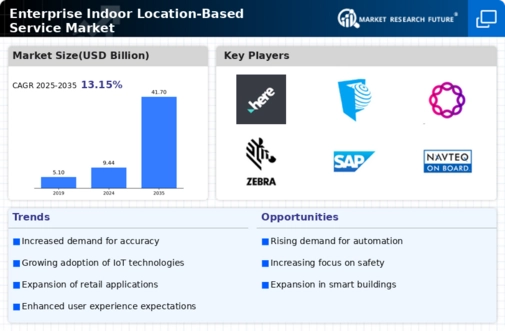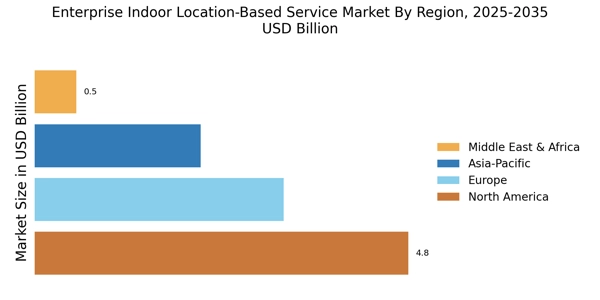Technological Advancements
The Enterprise Indoor Location-Based Service Market is experiencing a surge in technological advancements, particularly in the realms of artificial intelligence and machine learning. These technologies enhance the accuracy and efficiency of indoor positioning systems, allowing businesses to optimize their operations. For instance, the integration of AI algorithms can analyze vast amounts of data to provide real-time insights into customer behavior and movement patterns. This capability is crucial for industries such as retail and healthcare, where understanding customer flow can lead to improved service delivery. As a result, the market is projected to grow significantly, with estimates suggesting a compound annual growth rate of over 30% in the coming years.
Enhanced Customer Experience
The focus on enhancing customer experience is a pivotal driver within the Enterprise Indoor Location-Based Service Market. Businesses are leveraging location-based services to create personalized experiences for their customers. For instance, retail establishments can utilize indoor navigation to guide customers to specific products, thereby improving the shopping experience. Additionally, the ability to send targeted promotions based on a customer's location within a store can significantly increase sales. Market Research Future suggests that companies employing these strategies have seen a 20% increase in customer engagement, highlighting the effectiveness of indoor location services in fostering customer loyalty.
Growing Adoption of Smart Technologies
The growing adoption of smart technologies is a significant driver of the Enterprise Indoor Location-Based Service Market. As businesses increasingly invest in smart infrastructure, the demand for indoor location services is expected to rise. Smart buildings equipped with IoT devices can utilize location-based services to optimize energy consumption and enhance security measures. For instance, smart sensors can track occupancy levels and adjust lighting and climate controls accordingly. This integration not only improves operational efficiency but also contributes to sustainability efforts. Market forecasts indicate that the adoption of smart technologies will propel the indoor location services market, with a projected growth rate of over 25% in the next few years.
Regulatory Compliance and Safety Standards
Regulatory compliance and safety standards are increasingly influencing the Enterprise Indoor Location-Based Service Market. Organizations are required to adhere to various safety regulations, particularly in sectors such as healthcare and manufacturing. Indoor location services can assist in ensuring compliance by providing real-time tracking of personnel and assets, thereby enhancing workplace safety. For example, in healthcare facilities, these services can help monitor the location of medical equipment and staff, ensuring that they are in compliance with safety protocols. The market is likely to see growth as more organizations recognize the importance of integrating location-based services to meet regulatory requirements.
Increased Demand for Operational Efficiency
The drive for operational efficiency is a key factor propelling the Enterprise Indoor Location-Based Service Market. Organizations are increasingly recognizing the value of location-based services in streamlining their processes. For example, in logistics and warehousing, indoor positioning systems can facilitate better inventory management and reduce operational costs. By utilizing these services, companies can enhance their supply chain efficiency, leading to faster delivery times and improved customer satisfaction. Market data indicates that businesses implementing these solutions have reported up to a 25% reduction in operational costs, underscoring the financial benefits of adopting indoor location technologies.



















Leave a Comment